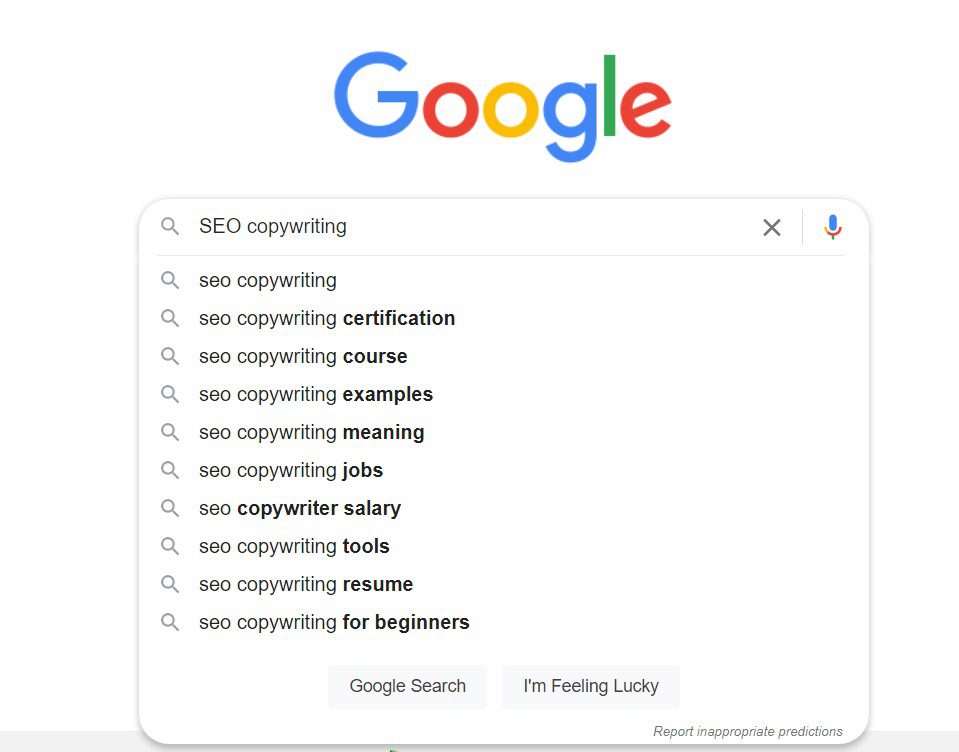
Content marketing is nearly unrecognizable from what it was a few years ago. Despite the growth of newer practices like omnichannel marketing and short-form social media ads, there’s one form of marketing that’s only going to get more relevant as time goes on: SEO copywriting.
Get up to speed on SEO writing with our comprehensive guide, you might just pick up a few unique tips and tricks along the way!
Table of Contents
What Is SEO Copywriting?
For beginners, SEO copywriting is the art of writing to persuade readers to act, usually to purchase or subscribe to a product, all while ensuring that your content is ranked well by search engines. People tend to view blogs, emails, and social media ads as examples of SEO copywriting, but that’s not always the case.
For example, some copywriters do specialize in social media, but they might not necessarily be optimizing their content to align with the ever-shifting demands of a search engine algorithm. The conditions for a social media post to perform well are different from those required for a high-ranking blog—which is where SEO copywriting comes in.
The reason SEO writing tips are so in demand right now lies in a simple statistic: a whopping 70.4% of internet traffic goes to the top 5 ranked websites for a given search. Optimized copywriting allows smaller businesses to climb up to that threshold, and it helps industry leaders maintain their advantage. Mastering SEO copywriting is the key to boosting your traffic, conversion rates, and so much more.
Step 1: Planning
There’s a lot in common between other types of copywriting and SEO copywriting, and one of the most visible examples is planning. Great copy begins with great planning, and you’re going to have to do even more of it when it comes to SEO writing. Start with an outline. The more detailed your outline, the easier it’ll be to create copy that both flows and performs well.
Keyword Research
A popular SEO writing tip is to start your outline with the keywords. These keywords are targeted terms that users are going to employ when searching for a given product or service. The keywords you decide to optimize for will end up shaping the direction of your writing, which is why most experts recommend starting with this step.
Beginners to SEO copywriting should know that there are different types of keywords, each with a different use case for a specific scenario.
Short-tail keywords: Also known as ‘head terms’, these phrases contain 3 words or less. Examples of short-tail keywords for SEO copywriting could be vague descriptors like ‘game console’ or ‘vampire movie’. Users who employ these search terms generally don’t have a specific product or service in mind, and these terms tend to be highly competitive as a result.
For example, searching ‘game console’ will bring up products for sale, informational articles, and news items—all on page 1. It’s not clear what the user wants.
Long-tail keywords: Chances are you’ve probably heard of long-tail keywords somewhere in a SEO writing tip. These keywords are highly prized because they give a window to the user’s intent. In fact, about 91% of all search queries involve long-tail keywords. Long-tail keywords will be more specific phrases of 4 words or more.
For example, someone who knows what type of console they’re searching for might use the long-tail term ‘4K HDR game console bundle.’ This yields more directed results.
Middle-tail keywords: It’s not all black-and-white with keywords. A great tip for beginners to SEO writing is to keep an eye out for these ‘medium-tail keywords.’ Medium-tail keywords are between 2-4 terms long and generally contain the best of both worlds. They’re specific enough to get you high-value visitors while also being general enough to generate considerable traffic.
The ideal keyword type for a page will vary depending on what the business wants to achieve. Writers might initially believe that long-tail keywords are the way to go, but the best examples of SEO copywriting will strike a balance between long and short-tail keywords.
Determine Intent
A valuable tip for SEO writers is to always keep an eye on search intent. Google’s algorithms aren’t just matching keywords to what’s on your page; they’re also going to be judging user intent. Understanding user behavior can give you a unique perspective on what kind of terms they might use while searching.
A fun way to do this for beginners is to ask these SEO writing questions:
- Who am I writing for?
- What is my copy supposed to achieve?
- What steps can I take to achieve those targets? (Keywords, tone, and structure.)

This homepage banner has a clean, simple design while still incorporating keywords and a call to action with the user’s intent in mind.
Consider this example of SEO copywriting. We’re integrating a medium-tail keyword, ‘Youtube Shopify Integration,’ in a way that reads naturally while still adding a catchy hook to draw potential readers in. The age-old writing tip about knowing your audience before you’ve even written the first word still holds true for SEO.
Create an Outline
Creating a comprehensive outline is a great way for beginners to get started with SEO writing. Once you’ve got your keywords ready and an audience in mind, you’re ready to bring them together into a single document.
You’ll want to start by laying out your keywords and ranking them in order of priority. This will depend on what your goals for a specific page are. Certain blogs might call for a long-tail primary keyword, while others will require a short-tail strategy. A practical tip for SEO writers struggling to figure keyword priority out is to consider the final goal of the page when judging keywords.
This is also the stage where you’ll be deciding on a final structure for the copy. There are tons of different structures that SEO copywriters work with. For example, an informative blog on a technical topic would usually follow a standard long-form structure with headings, subheadings, and paragraphs (like this article!). On the other hand, a small product page would typically involve shorter sentences and a creative blend of copy and graphics.
Step 2: Writing
Once you have an outline ready, all that’s left to do is write! Make sure you’ve got your audience and final goal in mind before you start writing, whether that’s increasing web traffic or generating more revenue. The hard part’s over, but we thought we’d prepare a few writing tips for beginners to SEO.
- Balance: SEO copywriting involves learning to write for search engines, but that doesn’t mean you should forget the human element. Space your keywords out rather than overusing them in places that don’t make sense. What’s an appropriate spacing? Most SEO experts agree that keyword density should be about 1%, meaning one keyword for every 100 words. While this isn’t a hard-and-fast rule, Google does warn against keyword stuffing, telling content creators that an irrelevant overuse of keywords will hurt their rankings.
- Engage: Readers will only spend an average of 37 seconds on an article. You could have the catchiest header, but your readers won’t stick around if your content doesn’t engage them. Great examples of SEO copywriting will take every chance to engage visitors with interactive content like images and videos.

That said, you might not always have the budget to incorporate videos or licensed images in your copy. That’s where lists come in. A common tip given by SEO writing experts is that if you have to choose between a paragraph or a list, choose the latter. Lists get the point across without crowding up the page. They cost nothing to implement, and your readers will thank you for it.
- Edit: Never underestimate the power of editing. You might be surprised by what you catch during a revision. Keep an eye out for typos as these can severely damage your credibility, particularly for more technical articles. You’ll also want to take this chance to ensure your keywords aren’t too far apart or too close together—balance is key here.
Step 3: Optimize!
This step is just as important as writing. Follow these examples of SEO copywriting best practices to go from a good to great SEO copywriter. Most SEO writing tips in this section will involve minor tweaks, but they’re going to add up to boost your rankings.
Linking
Long gone are the days when Google’s algorithm only looked at keywords in order to rank pages. Their new, more advanced algorithm will also examine the links present on your page and their overall relevance to come up with a ranking.
Beginners to SEO writing should remember to include relevant, well-researched links throughout their copy. Not only do these links add credibility to what you’re saying, but they’re also going to improve your rankings by helping users explore your website. Keep an eye out for these links:
- Internal: Internal links connect the various pages of your website. They’re easily identifiable by their common domain names. A common tip for SEO writers is to always provide internal links in relevant places. Doing so can indirectly boost traffic for other internal pages by helping visitors navigate your website.
- Inbound: These links are the hardest to obtain, but they’re also the most valuable. These are links present on other websites that bring visitors to yours. If a highly trustworthy website links to your page, the algorithm will take that as an indication of your content’s high quality. Guest posts are a natural way to build inbound links.
- Outbound: Outbound links lead from your website to other domain names. Remember to sprinkle these links in if the copy calls for it. An easy example of an SEO copywriting scenario where outbound links could be useful is a blog. Writers usually employ them to cite their sources and statistics—use this as an opportunity to link to credible websites. There’s some debate as to whether outbound links directly improve page ranking, but they can at least improve the user experience of your website and raise your credibility.
Best Practices For Writing
Links are great to have, but style in SEO writing is what ultimately tips the scales towards a conversion. Style, in this case, involves mastering tone, flow, and structure.
- Active Voice: Most pieces of advice for beginners to SEO writing begin with an emphasis on the active voice. Active voice gives you agency over your writing, using fewer words to make a greater impact. Getting the active voice down is an invaluable part of creating engaging content for readers.
- Flow: Adding in transition words and tweaking your sentence lengths to be shorter can do wonders for readability. Great copy helps readers glide through the page and seamlessly converts them. If you’re working on long-form copy, break your writing down into headings and subheadings for a smoother experience.
- Call To Action: A great call to action (CTA) is the last piece of the funnel created by your copy. Include a clear and visible CTA to help your readers take the next step on their customer journey. A typical example used in SEO copywriting is ‘Buy Now,’ but you can get creative with these if the occasion allows for it.
- Alt-text: This is a small snippet that describes what an image is about. SEO writers often overlook this tip, but it can go a long way in building website credibility. Alt-text primarily helps users navigate your website in the event of the image not loading, but it also helps search engines understand your content.

Alt-text lengths are usually between 4-8 words, and they’re incredibly easy to write! Be specific and descriptive with your alt-text without making any irrelevant judgments about what’s in the image. Try to include your primary or secondary keywords in your alt-text if the image permits, but don’t try to force them in if the image has nothing to do with your keywords.
Writing That Converts
SEO copywriting is an invaluable tool both for beginners and marketing experts. Use these SEO writing tips to grow your brand with powerful writing that dominates search engine rankings. Learn more by following Coalition Technologies, a marketing pioneer that helps businesses make a mark with innovative SEO strategies.


